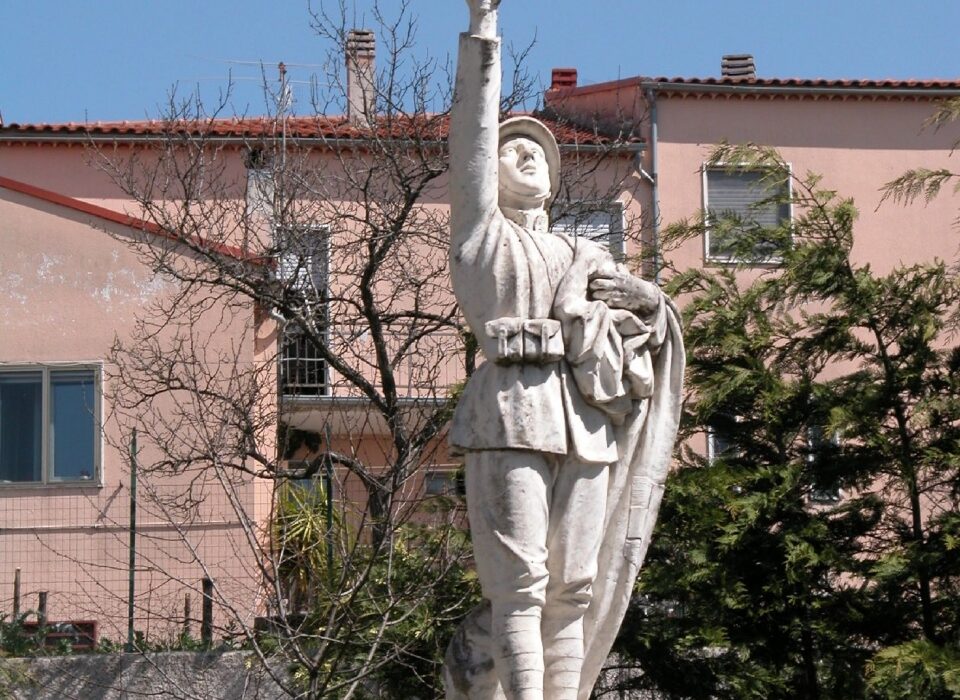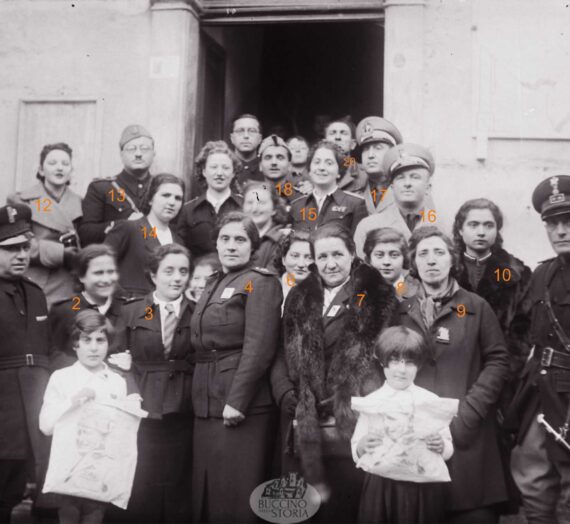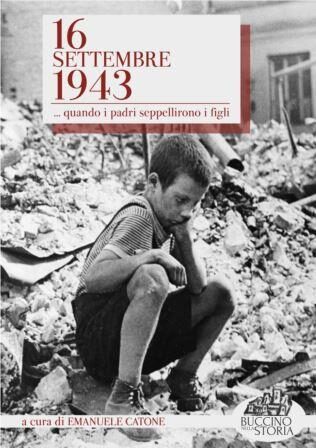by Emanuele Catone and Antonella Freda
The Monument to the fallen of Buccino
The monument to the fallen of Buccino, made of white marble by the architect Andrea Remedi of Massa Carrara, depicts on the pedestal an infantryman who, clutching the flag of his country to his chest, he holds in his right hand a gladius outstretched lost from above1.
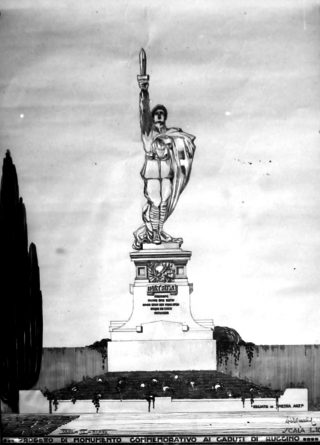
Placed in a small fenced flowerbed, located in the clearing in front of the Town Hall (formerly Largo S. Antonio today Piazza Municipio), on the four sides of the base were placed the tombstones containing the names of the 119 fallen Buccinesi of the Great War, divided by year, while a commemorative inscription was engraved on the central facade of the monument, composed by prof. don Antonio Grieco, which recites:
HERE IN THE SMILE, OF GLORY / AFTER THE GREAT WAR 1915-18 / OUR DEAD RELIVE / ADDITING THE HOMELAND TO THE IMMEMORS / AND TO ALL ONE LAW / THE DUTY / 31-7-1921

Two bombards were then placed to the right and left of the monument (war prey) offered by the Ministry of War and arrived from Taranto, which were housed on four iron trestles built for the purpose by the Buccinese blacksmith Giulio Del Chierico. 2
Later rededicated to the fallen of the Second World War, behind the monument were then added two other gravestones bearing the names of the 43 Buccinesi who died in the war between 1935 and the 1945.
The initiative for its realization was due to the mayor Cav. Giuseppe Verderese, that, flanked by a “Committee for a monument to the soldiers of the Municipality who died in war” in May 1919 promoted a public subscription for this purpose. In August 1921 the City Council unanimously granted free use of the space identified for the monument and the monument was inaugurated on June 8 1924 in the presence of civil and military authorities. Local historian Ernesto Grieco reports that they were present: «S. E. General Conte Boffa di Perrero representing S. M. Vittorio Emanuele III, [… the] General Commander of the Military Division Masci, [… the] Subprefect of Campagna Conte Di Castro, [… the] cav. lawyer. Guido Vestuti president of the Provincial Federation of War Mutilated, [… e] many other provincial and local authorities ". Again from Grieco we know that «Colonel Vaccari, Extraordinary Commissioner of the Municipality of Buccino, he greeted the people who attended, extolling the Buccinese patriotism; then spoke the official speaker Avv. Guido Vestuti who exalted the sacrifice of the fallen heroes and remembered the deeds for each of them, exalted its value "; the monument therefore received the blessing of the Buccinese priest Don Nicola D'Acunto, who had been a military chaplain during the war.
As "the Committee of the festivities [had collected] among the population a sum lower than the budgeted one, and this also due to the fact that the public signature in this regard [had been] held parallel to that for the feast of the patron saint and San Vito " 3, the Municipality in 1924 provided a series of public grants to cover the various expenses incurred for the inauguration and preparation of the monument and the Remembrance Park. From the deliberations of the prefectural commissioner of the time, Colonel Antonio Vaccari, we know that the Municipality allocated 1500 lire for expenses "for music, flags, school lunch etc. " it took place for the inauguration of the war memorial and the Remembrance Park, I pay 201 lire to Orazio Magaldi for the rental of his car used for the transfers of the authorities between the railway yard and the country, e 25 lire to Giovanni Sciarrillo, who had taken care of transporting with his cart the "mortella needed for the decoration and festoons" 4.
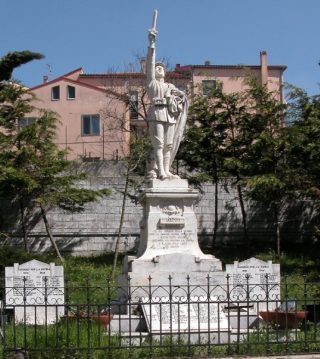
The Park of Remembrance of Buccino
The same day (8 June 1924) the nearby Parco della Remembranza was also inaugurated.
At the invitation of the Undersecretary for Education, indeed, in March 1923 the Committee to promote the constitution of the Park was set up in Buccino, chaired by the city councilor D'Acunto and composed by Ernesto Grieco, Paolo Mastursi, Francesco Goffredi, Carlo Verderese and Italo Pesce (secretary), who had immediately applied to the Ministry of Education to obtain the plants, and the 24 marzo 1923 the municipal council, on the proposal of the director Carlo Bosco, had intended the entire ancient garden of the Augustinian convent for this purpose - which until the previous year had been rented by Francesco D'Acunto, manager of the steam mill located in the premises below the municipal offices 5 - undertaking to bear the expenses necessary for the construction of the boundary wall, of the high iron balustrade 40 cm resting on it and the iron entrance gate with a width of 5 meters. The City Council confirmed the authorization for the construction of the Park with its resolutions of 29 May and 4 August 19236.
The resolutions with which the payments of the expenses incurred were authorized make it possible to know who carried out the necessary work.
They were planted in the garden 119 trees bearing a metal plate with the names of the fallen Buccinese soldiers. The 14 April 1924, since the works for the park had not yet begun "due to the continuous concerns and solicitations of the Ministry of Education and the widows and parents of soldiers who died in the war", Prefectural Commissioner Vaccari authorized the purchase of the oriental plane trees necessary for the purpose, which were supplied by the Giuseppe Malagola company in Mercato San Severino for a total cost of 621 read7.
The entrance gate and railing were made by the "mechanic Eduardo Magaldi" for a cost of about 169 read8. The two concrete vases placed on the pillars at the sides of the entrance gate to the park were supplied by the Di Filippo Brothers of Salerno and transported from Salerno to Buccino by the carter Alberto Tagliaferri for a cost of approximately 150 read9.
The construction of the boundary wall, the installation of the gate and its supporting pillars, as well as the construction and whitewashing of the southern wall, were made by the entrepreneur Nicola Basile, for a total cost of 3279 read10.
The crushed stone necessary to create the avenues of the Park was excavated on the coasts of Rossara and Cornito11.
To take care of the manual work for the planting of trees and for the internal arrangement of the Park («Earthworks and quarrying of the 119 it was one cubic meter for the plantation of plane trees ", "Settlement and leveling", "Spreading and gravel and building the driveway") were the workers Giuseppe Roccia, Francesco Di Leo, Francesco Muccione, Trimarco Saturday, Concetta Capo, Giuseppina Candela, Immaculate Tortoriello and Caterina Ferrara, for a total cost of over 855 read12.
The necessary wooden poles were cut by the workers Michele Tuozzo di Pasquale and Ferdinando Basile in the municipal wood of S. Nicola; Francesco Mangini, operator of an electric sawmill, took care of sawing the timber for the "formation of the rules needed to repair the plants" and the carpenter Vincenzo Picciuolo di Giuseppe to build the "357 strips of chestnut wood for the formation of the rules needed to repair the plants" and to "paint them to linseed oil »for a total cost of 480 read13.
On the occasion of the inauguration of the Park 28 war orphans obtained the badge of honor from the Commander of the Campaign Military District.
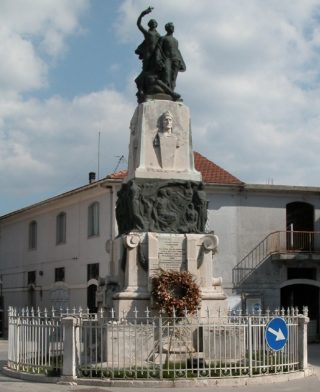
The war memorial erected in Piazza Municipio, of complex workmanship, it is certainly one of the most beautiful in our province.
It depicts an allegory of victorious Italy and is composed of a quadrangular stone base on which the altar rests with the commemorative inscription to the Gregorian fallen from the Great War and the list of those killed in the two world wars and the Spanish War.
The inscription on the base reads:
MAG. 1915 – NOV 1918 / ALL THE ANIMALS GLORIFICATE / OF THE YOUNG CAMPANI / THAT / FROM THE SOLITARY BALZE OF S. GREGORY THE GREAT / ALTARS OF LABORIOUS BROTHERHOOD / THEY WENT TO SACRIFY THE FRESH SERENE LIFE / FOR THE GREATNESS OF THE COUNTRY / OFFER / IN THE WITNESS OF DEVOTION / THIS UNDERGROUND SYMBOL OF ITALIAN VICTORY / HEARTS OF THE COUNTRIES / INTENT TO PERPET / ON THE NATIVE SOIL / AND ON DISTANT PLAGAS / THE TRADITION OF HOLY SOLIDARITY WORK / 1926
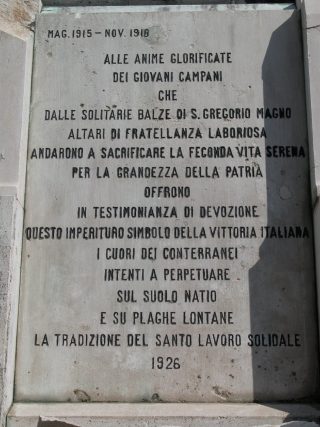
The upper band is made up of four allegorical bronze reliefs, marked at the corners by two female figures and those of Dante Alighieri and Giuseppe Verdi. Further depictions of the great poet and the Emilian musician, together with those of the Count of Cavour and Giuseppe Mazzini, as symbols of a united Italy, they are carved in stone on the four sides of the upper block, which acts as a base for the upper group in bronze depicting a woman raising an olive branch to the sky, and a shirtless soldier, wrapped in a drapery, holding a shield and placing his hand on the head of a dying fellow soldier.
The monument is traditionally attributed to the Salerno sculptor Gaetano Chiaromonte. Inspirational, however, the Gregorian Nicolò Mele was also the promoter and co-author of the work (1873-1946), mayor of S. Gregory the Great from 1918 al 1922 (photo). From family memories handed down by Elio Mele about his grandfather Nicolò, we know in fact that Nicolò Mele had an artistic education, having completed his studies at the Academy of Fine Arts in Naples, where he was a pupil of Filippo Palizzi, Domenico Morelli, Gioacchino Toma and Stanislao Lista, and it was in Naples that he made friends, among others, with Gaetano Chiaromonte.
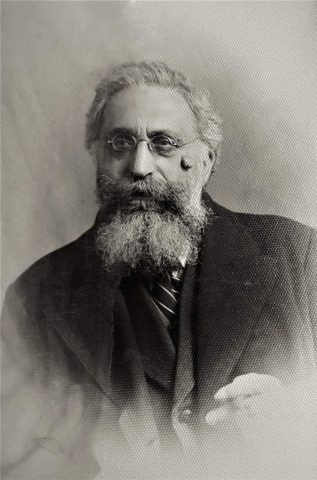
When the premature death of his 21-year-old brother Alfonso (1899), forced him to return to San Gregorio Magno, together with his brother-in-law Enrico Lordi, magistrate and also of Gregorian origins, and to his cousin Nicola Mele, there he founded the Society of Arts and Crafts, of which he was President and main animator. His love for culture and homeland history, which also led him to be appointed Honorary Inspector of Antiquities, caused him to put together a precious collection of antiquities found in S. Gregorio Magno and then donated to the Provincial Archaeological Museum of Salerno, where they are still stored today. Engaged in local politics, Nicolò Mele reached the office of mayor in the spring of 1918 and among the various public works carried out during his years as a union there was the excavation of the San Gregorio Magno road – Oliveto Citra e, precisely, the construction of the war memorial.
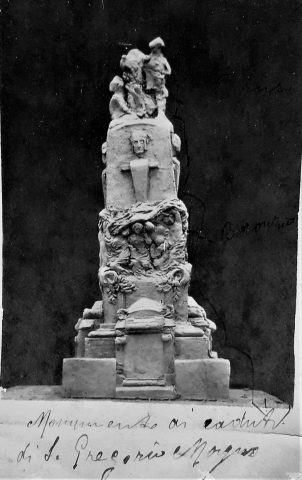
Given his artistic training, Mele elaborated the general project of the sculptural work and molded the first sketch in clay and then, to make it happen, went to Naples to exhibit his project to his friend Alberto Ferrer who found the idea interesting but, for the numerous works already commissioned to him, he had to give up but suggested that Mele turn to Chiaromonte, who immediately accepted the assignment but, given its neoclassical taste, suggested the replacement of the crowning group. When work began to shape the marble and to make the casts for the casting of the bronze parts, Mele, who for study reasons had moved to Naples with his family, was able to follow the realization of the work step by step. When, when the job is finished, everything had to be transported to San Gregorio Magno, which involved an expensive expense: since the municipal coffers could have very little, Nicolò Mele obtained grants from the local bank and from some private Gregorian citizens who could afford it, among which we remember first of all Beniamino Calabrese and Nicola Mele. When the portions of the monument reached S.. Gregory the Great, they moved on to their positioning and assembly; it was not Chiaromonte who managed this phase - whose signature is affixed only to the base of the crowning group, only portion of the monument of its exclusive design -, who was never present but sent one of his master builders to offer the necessary help to Mele, who mainly used local labor for the work, voluntary or with few economic claims. The assembly and placement of the work were completed in 1921, but the monument had to be inaugurated in 1926, date indicated in the dedicatory inscription.
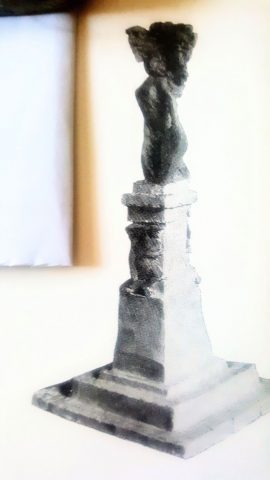
Subsequently Nicolò Mele prepared two other clay sketches which, in his intentions, had to be transformed into as many works of art: it was a winged Nike to be placed in Piazza San Vito and a large fountain destined for an unspecified place in S. Gregorio, of whose sketch unfortunately there is no longer any testimony, not even photographic, so long as, being of unbaked clay, it was gradually pulverized by erosion. In Mele's idea, the two additional works, unfortunately never realized, they should have shown that even a community made up of a population with a predominantly agricultural economy, which was the Gregorian one, could hold a respectable artistic heritage.
We thank Elio Mele for the news and unpublished photos generously placed at our disposal.
The modern photos of the monuments are taken from the General Catalog of Cultural Heritage: Buccino, Saint Gregory the Great.
Bibliography
Giuseppe Arduino, Archaeological discoveries in the territory of San Gregorio Magno. The collection of Inspector Mele in the Provincial Museum of Salerno, in "The Voice of Buccino", a. XIV, n. 4, Winter 2008, pp. 3-4.
Rose idol, Saint Gregory the Great (To), from its origins to the present day, Palomonte, Parisi graphics, 2004, p. 164.
Ernesto Grieco, Buccino - Antica Volcei, Salerno 1959, pp. 86-87
Maria Rosaria Nappi (the care of), Campania and the great war. The monuments to the fallen of the Province of Salerno, Roma, Gangemi, 2009, pp. 123, 127-129.
Note
- In 1934 the wall behind the Monument was rearranged and the Roman dagger that had been blown away by the wind was put back in place. In 1953 a copy of the infantryman was made by the Remedi company for the monument in the Calabrian municipality of Drapia (VV)
- Nicola Li Santi di Pasquale obtained a payment of 93,35 lire for the freight paid to the Railways for the transport of the bombarde from Taranto to Buccino and for their transport from the airport to the town (Municipality of Buccino Archive, Resolutions of the Prefectural Commissioner, n. 142 of the 24 May 1924) The blacksmith Del Chierico instead obtained a compensation of 60 read (Resolutions of the Prefectural Commissioner, n. 149 of the 30 May 1924)
- Resolutions of the Prefectural Commissioner, n. 153 of the 31 May 1924
- Resolutions of the Prefectural Commissioner, nn. 153 of the 31 May 1924 e nn. 161-162 of the 10 June 1924
- Cfr. E. Catone, "The whistle of the steam engine". The mill-mill planted in the former Augustinian convent of Buccino (1880-1929), in "Historical Annals of Principality Citra", XIV/1, 2016, pp. 124-153, who P. 149 note 73
- Resolutions of the City Council, n. 2209 of the 24.3.1923
- Resolutions of the Prefectural Commissioner, n. 98 of the 14 April 1924. Donnino De Lucia di Fortunato took care of the transport of the plants from the railway station to the town and of the payment of the rail freight for their transport. 30,90 read (Resolutions of the Prefectural Commissioner, nn. 99 of the 16 April 1924 e 108 of the 19 April 1924). The Prefectural Commissioner also authorized the payment of 50 lire in favor of the "Archimede" Institute of Rome for the construction of 10 enameled iron plaques for the Park (Resolutions of the Prefectural Commissioner, n. 150 of the 30 May 1924).
- Resolutions of the Prefectural Commissioner, nn. 114 of the 28 April 1924 e 184 of the 28 July 1924.
- Resolutions of the Prefectural Commissioner, n. 163 of the 18 June 1924
- Resolutions of the Prefectural Commissioner, nn. 97 of the 11 April 1924, 104 of the 17 April 1924, 131 of the 1 May 1924
- The Municipality paid 40 lire to the worker Gregorio Malpede for the 4 days of work needed to dig the rubble on the Rossara coast (Resolutions of the Prefectural Commissioner, n. 151 of the 30 May 1924) e 50 lire to Umberto Iannone for the working day used to transport with his tow the brecciame from the municipal coasts of Cornito to the Park (Resolutions of the Prefectural Commissioner, n. 184 of the 28 July 1924).
- Resolutions of the Prefectural Commissioner, nn. 106 of the 17 April 1924, 132 of the 1 May 1924, 159 of the 10 June 1924.
- Resolutions of the Prefectural Commissioner, nn. 134 of the 16 May 1924, 143 of the 24 May 1924, 158 of the 10 June 1924.

